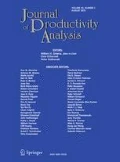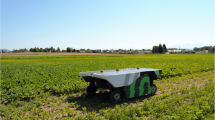Abstract
The New Zealand North and South Island dairy farms differ in terms of climate, soil type and farming history. Using stochastic frontier models, an unbalanced panel of 1,294 dairy farms for the period between 1998/99 and 2006/07 is employed to test the hypothesis that the two regions share the same technology (The New Zealand dairy season runs from 1 June to 31 May each year). Results indicate heterogeneity in production technology across farms located in different islands. A meta-frontier model proposed by Battese et al. (J Product Anal 21:91–103, 2004) and O’Donnell et al. (Empir Econ 34:231–255, 2008) is therefore used to calculate the technological gap and compare on-farm technical efficiency.



Similar content being viewed by others
Notes
Given this assumption, the simultaneous-equation bias often associated single-equation production models is avoided (Zellner et al. 1966).
O’Donnell et al. (2008) pointed increases in the (technology gap) ratio imply decreases in the gap between the regional frontier and the meta-frontier, the use of MTR instead of TGR helps avoid the confusion.
Capital stock itself is distinct from the flow of capital services obtained from it, and it is the later that should represent ‘capital’ in production functions. But data dictate what we can do; there is no detailed information to reflect capital stock durability and composition. The use of the capital stock concept instead of the service flow concept may bias the estimation results if the capital service flow is a function of capital vintage as shown by Yotopoulos (1967). This is especially a concern with the expansion that has occurred in the South Island, as the use of capital stock places more weight on the more durable asset, such as irrigation and new land purchased. It would be particularly useful if more information on capital is collected in future surveys.
This was a reasonable assumption to make in the NZ dairy inputs market.
Four farms in the sample have zero value observations for electricity expenses, 2 farms have zero observations for feed expenses, and 33 have zero observations for fertilizer expenditure. Given that the “zero cases” are not a significant proportion in the sample, and they are perceived to be useful in the estimation of parameters which are common to all farmers, we adopted the approach of including "zero cases" by using the value of one. See Battese (1997) for a more detailed discussion on handling a significant proportion of "zero observations" when estimating agricultural production functions.
This is similar to Mbaga et al. (2003), Saha and Jain (2004), and Hailu et al. (2005). The production unit is the 'cow' rather than the 'farm'. This specification implicitly assumes that the per-cow technology is invariant with respect to cows. It is also equivalent to impose CRTS on a production function with the 'farm' as the production unit and the 'cow' as an input on the right hand side. We acknowledge that for those who prefer to have the latter, the returns to scale (RTS) in this per-cow specification is not RTS in the usual sense, they might characterize changes in inputs per cow as changes in inputs mix. Therefore a researcher might want to consult on the production unit in practice before the specification of a production function.
Irrigation data was not collected for season 2001/02 so the variable cannot be used in constructing the frontier.
The average dairy land price went up by 91 % over this sample period.
The correlation coefficients of TE estimates obtained between CD and TL frontiers were in the range of 0.98 and 0.88 for this study.
Both the two-sample t test and the Wilcoxon rank-sum test reject the equality of mean TE scores between North Island and South Island at better than a 1 % significance level.
A New Zealand dairying regional map is attached in Appendix.
Waikato also has the largest number of observations.
The average TE is 92.3 % in 2006/07 for South Island as shown by Fig. 3, and the most efficient farm was estimated to have a TE score of 98.4 %.
References
Ahmad M, Bravo-Ureta BE (1996) Technical efficiency measures for dairy farms using panel data: a comparison of alternative model specifications. J Product Anal 7:399–415
Battese GE (1992) Frontier production functions and technical efficiency: a survey of empirical applications in agricultural economics. Agric Econ 7:185–208
Battese GE (1997) A note on the estimation of Cobb–Douglas production functions when some explanatory variables have zero values. J Agric Econ 48:250–252
Battese GE, Coelli TJ (1988) Prediction of firm-level technical efficiencies with a generalized frontier production function models. J Econom 38:387–399
Battese GE, Coelli TJ (1995) A model for technical efficiency effects in a stochastic frontier production function for panel Data. Empir Econ 20:325–332
Battese GE, Rao DSP (2002) Technical gap, efficiency, and a stochastic metafrontier function. Int J Bus Econ 1:87–93
Battese GE, Rao DSP, O’Donnell CJ (2004) A metafrontier production function for estimation of technical efficiencies and technology gaps for firms operating under different technologies. J Product Anal 21:91–103
Bravo-Ureta BE, Rieger L (1991) Dairy farm efficiency measurement using stochastic frontiers and neoclassical duality. Am Agric Econ 73:421–428
Bravo-Ureta BE, Solis D, Moreira VH, Maripani J, Thiam A, Rivas T (2007) Technical efficiency in faming: a meta-regression analysis. J Product Anal 27:57–72
Brümmer B, Loy JP (2000) The technical efficiency impact of farm credit programmes: a case study of Northern Germany. J Agric Econ 51:405–418
Caudill S (2003) Estimating a mixture of stochastic frontier regression models via the EM algorithm: a multiproduct cost function application. Empir Econ 28:581–598
Coelli TJ (1995) Recent developments in frontier modeling and efficiency measurement. Aust J Agric Econ 39:219–245
Coelli TJ (1996) A guide to FRONTIER version 4.1: a computer program for stochastic frontier production and cost function estimation. CEPA working paper 7/96, School of Economics, University of New England, Armidale
Coelli TJ, Rao DSP, O’Donnell CJ, Battese GE (2005) An introduction to efficiency and productivity analysis, 2nd edn. Springer, New York, p 212
Cooper MH, Boston J, Bright J (2012) Policy challenges for livestock emissions abatement: lessons from New Zealand. Clim Policy. doi:10.1080/14693062.2012.699786
Cuesta RA (2000) A production model with firm-specific temporal variation in technical inefficiency: with application to Spanish dairy farms. J Product Anal 13:139–158
Dawson PJ (1987) Farm-specific technical efficiency in the England and Wales dairy sector. Eur Rev Agric Econ 14:383–394
Good DH, Nadiri MI, Roller L, Sickles RC (1993) Efficiency and productivity growth comparisons of European and US air carriers: a first look at the data. J Product Anal 4:115–125
Greene W (2002) Alternative panel data estimators for stochastic frontier models. Working paper, Department of Economics, Stern School of Business, NYU
Hadley D (2006) Patterns in technical efficiency and technical change at the farm-level in England and Wales, 1982–2002. J Agric Econ 57:81–100
Hadri K, Whittaker J (1999) Efficiency, environmental contaminants and farm size: testing for links using stochastic production frontiers. J Appl Econ 2:337–356
Hailu G, Jeffrey S, Unterschultz J (2005) Cost efficiency for Alberta and Ontario dairy farms: an interregional comparison. Can J Agric Econ 53:141–160
Hallam D, Machado F (1996) Efficiency analysis with panel data: a study of Portuguese dairy farms. Eur Rev Agric Econ 23:79–93
Hayami Y (1969) Sources of agricultural productivity gap among selected countries. Am J Agric Econ 51:564–575
Hayami Y, Ruttan VW (1970) Agricultural productivity differences among countries. Am Econ Rev 60:895–911
Hayami Y, Ruttan VW (1971) Agricultural development: an international perspective. John Hopkins University Press, Baltimore
Jaforullah M, Devlin NJ (1996) Technical efficiency in the New Zealand dairy industry: a frontier production function approach. New Zealand Economic Papers 30:1–17
Jaforullah M, Premachandra E (2003). Sensitivity of technical efficiency estimates to estimation approaches: an investigation using New Zealand dairy industry data. Economics discussion papers no. 306, The University of Otago, Dunedin. Last retrieved June 19th 2009 at: http://www.business.otago.ac.nz/ECON/research/discussionpapers/DP0306.pdf
Jaforullah M, Whiteman J (1999) Scale efficiency in the New Zealand dairy industry: a non-parametric approach. Aust J Agric Resour Econ 43:523–541
Jiang N, Sharp B (2008) Technical efficiency analysis of New Zealand dairy farms: a stochastic production frontier approach. 13th New Zealand Agricultural and Resource Economics (NZARE) conference papers, Nelson
Kompas T, Che TN (2006) Technology choice and efficiency on Australian dairy farms. Aust J Agric Resour Econ 50:65–83
Kumbhakar SC, Heshmati A (1995) Efficiency measurement in Swedish dairy farms: an application of rotating panel data, 1976–88. Am J Agric Econ 77:660–674
Maddala GS (1979) A note on the form of the production function and productivity. In: Measurement and interpretation of productivity. National Academy of Sciences, Washington, D.C., pp 309–317
Mbaga MD, Romain R, Larue B, Lebel L (2003) Assessing technical efficiency of Québec dairy farms. Can J Agric Econ 51:121–137
Moreira VH, Bravo-Ureta BE (2010) Technical efficiency and metatechnology ratios for dairy farms in three southern cone countries: a stochastic meta-frontier model. J Product Anal 33:33–45
O’Donnell CJ, Rao DSP, Battese GE (2008) Metafrontier frameworks for the study of firm-level efficiencies and technology ratios. Empir Econ 34:231–255
Orea L, Kumbhakar SC (2004) Efficiency measurement using a latent class stochastic frontier model. Empir Econ 29:169–183
Pierani P, Rizzi PL (2003) Technology and efficiency in a panel of Italian dairy farms: an SGM restricted cost function approach. Agric Econ 29:195–209
Reinhard S, Thijssen GJ (2000) Nitrogen efficiency of Dutch dairy farms: a shadow cost system approach. Eur Rev Agric Econ 27:167–186
Reinhard S, Lovell CAK, Thijssen G (1999) Econometric estimation of technical and environmental efficiency: an application to Dutch dairy farms. Am J Agric Econ 81:44–60
Rouse P, Chen L, Harrison JA (2009) Benchmarking the performance of dairy farms using data envelopment analysis. 2009 Performance Measurement Association (PMA) conference papers, University of Otago, Dunedin. Last retrieved April 19th 2011 at: http://www.pma.otago.ac.nz/pma-cd/papers/1052.pdf
Saha AK, Jain DK (2004) Technical efficiency of dairy farms in developing countries: a case study of Haryana State, India. Indian J Agric Econ 59:588–599
Yotopoulos PA (1967) From stock to flow capital inputs for agricultural production functions: a microanalytic approach. J Farm Econ 49:476–491
Zellner A, Kmenta J, Drèze J (1966) Specification and estimation of Cobb–Douglas production function models. Econometrica 34:784–795
Acknowledgments
The authors would like to thank the editors and the two anonymous referees for their constructive suggestions and comments that led to significant improvement of the paper. The authors are grateful to Matthew Newman from DairyNZ for making the data available.
Author information
Authors and Affiliations
Corresponding author
Appendix A: NZ dairying regional map
Appendix A: NZ dairying regional map

Rights and permissions
About this article
Cite this article
Jiang, N., Sharp, B. Technical efficiency and technological gap of New Zealand dairy farms: a stochastic meta-frontier model. J Prod Anal 44, 39–49 (2015). https://doi.org/10.1007/s11123-015-0429-z
Published:
Issue Date:
DOI: https://doi.org/10.1007/s11123-015-0429-z




